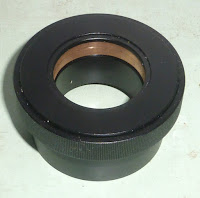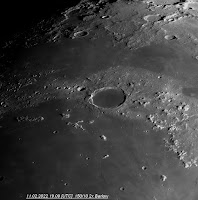*
The last post was becoming foolishly long. So I have copied and pasted the last bit here.
I purchased a set of sturdy, cast, shelf brackets: 200x250mm [8"x10"] These will support the bases of the slit ribs from the base ring. Due to the curvature of the base ring I could not use anything bigger. I need a space for the emergency hold downs. Along the top, inside edge of the base ring. This added to the severe limitations on bracket dimensions.
The base ring is presently only inches above the ground on the
southern [uphill] side. Making access to the underside almost impossible. I
have always planned to use the same, friction roller drive on the GRP
dome. It makes rotating the plywood dome completely effortless when the
base ring is dry.
From the comfort of my chair, at my imaging desk, I
can make the slit follow the sky. With just the slightest touch of the drive crank at
suitable intervals. No need for motors and batteries and sensors and
software. Moreover, I can turn the dome through 360 degrees in under a
second. If it ever proved necessary.
I am sorely tempted to raise
the GRP dome on a temporary roller ring. Just to test out its
performance and behaviour. This would probably require the dome was
lifted by at least a couple of feet above its present level.
The images above show my miserably failed attempts to use the jacks
successfully in moving the segments as delivered 100 meters away from my
home.
Supporting the dome on the rollers would allow me to be absolutely
certain of its dimensions, clearances and roundness. First it must be supported more
freely. The present stacks of wood blocks have considerable friction
with the dome skirt. The 7" crowned, nylon rollers would have very
little lateral friction. So the dome could relax into its natural form.
I
might even find the dome is considerably oval. So that it would not
accept being guided by the steering rollers. They might bind. Better to test all of this
while safely near the ground. Rather than once the crane operator has it
dangling high above the observatory buildings. Completely unable to put it
down!!
The main problem with a raised roller ring is stability. The ground slopes by nearly a foot over the width of the dome. This raises a serious hurdle against mass production of similar trestles. How can I judge the minimum, safe number of rollers? Do I need all fourteen for real world testing?
I only have six extra rollers. With the remaining eight still supporting the plywood dome. I'd have to make the steering rollers too. Or the whole thing will come crashing down. Using only six rollers probably means a load of 100kg per roller. There is still a large margin of safety for the rollers themselves. Much more doubt about localized loading. Pressing upwards, under the base ring/bracket/bolts and slit ribs.
Trestles would need a decent footprint to resist tipping in any direction. Then there is the matter of lifting the dome. I am used to using a 2x4 to lift a small section of the skirt. Though only a few inches at most. The dome is stiff enough to lift as a whole. It doesn't flex in any meaningful way.
It would need fixed trestles for safe and stable support. Then more trestles with the rollers fixed on top waiting inside the dome. Ready to be slipped under the base ring when the dome is high enough. How tall should these trestles be? Four legged 2x4 constructions?
I have caravan, parking jacks but they have foolishly small footprints. Very unstable! I have several, double, pilot wheel, trailer jacks. These could lift the dome by a much greater distance. Though they'd need a solid, dome sized frame to be stable. Just moving the dome segments down the drive on these proved to be a complete disaster. This was due to the torque they applied to the timber frame when the wheels were at right angles. The jacks must be placed on opposite sides of timber rails to balance out the torque. Difficult to do when there are so few of them! Only four, to be exact.

They have the claimed load capacity for the entire dome. However, all those wheels might give the dome the daft idea to head off downhill! If I placed these wheeled jacks between parallel 2x4s there should be no torque. I could easily replace the wheels with wooden blocks. That might work if I can clamp these jacks efficiently. Drilled hole through spaced pairs of 2x4s and clamping bolts? Lose the supplied clamps?
The advantage of the trailer clamps is easy adjustment of height by loosening the lever. Though that requires a very strong prop. To allow the jack wheels to drop freely to the ground.
Unfortunately the clamps are side mounted. Which forces heavy torque onto the clamps. Even ignoring the heavily offset [castoring] pilot wheels. The combination of offsets is a piss-poor design. Even a small car trailer, supported by the pilot wheel, shows serious twist in the towing beam to which it is clamped! It ought to be placed between the towing members. Not hanging off the side.
*














































